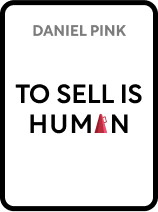

This article is an excerpt from the Shortform book guide to "To Sell Is Human" by Daniel H. Pink. Shortform has the world's best summaries and analyses of books you should be reading.
Like this article? Sign up for a free trial here .
Looking for Daniel Pink’s quotes from To Sell Is Human? What can you learn about modern sales from Pink’s book?
To Sell Is Human discusses traditional versus modern sales and picks apart practices that are no longer effective but are still commonly used. Pink asserts that we are all salespeople, whether we work in sales or not, and that the messages in his book are helpful for anybody in any profession.
Continue below for some of the best Daniel Pink quotes with explanations.
To Sell Is Human: Quotes and Passages
To Sell Is Human explains the history, evolution, and significance of sales. It challenges commonly held assumptions by redefining the meaning of sales, re-evaluating the purpose of the salesperson, and showing you how to effectively harness sales skills to create purpose, growth, or “movement” in your life (whether it be for personal or professional gain).
Here are some of Daniel Pink’s quotes from the book:
“The purpose of a pitch isn’t necessarily to move others immediately to adopt your idea. The purpose is to offer something so compelling that it begins a conversation, brings the other person in as a participant, and eventually arrives at an outcome that appeals to both of you.”
We need to clarify our pitches for this new age of over-information. We also need to gear them towards caveat venditor (being of service to the receiver). There are 6 types of pitches that can be used successfully in place of the elevator pitch.
Pitch #1: The One-Word Pitch
Brutally simplify your ideas down to one single word. Doing this creates clarity, and develops discipline. It also gets right to the heart of an idea, inspiring movement.
For example, during Barack Obama’s first presidential campaign, his one-word pitch was “change.”
Pitch #2: The Question Pitch
Take your idea, and pose a question that makes a statement. For example, instead of making the statement, “You will benefit from therapy,” you can ask the question, “How do you want to feel about yourself a year from now?” Research in the 1980s found that questions are more effective than statements when it comes to movement. Statements are ultimately passive and don’t allow for collaboration. Questions invite connection, contemplation, and collaboration, which creates movement.
Pitch #3: The Rhyming Pitch
Create a rhyming statement or question that gets to the core of your idea. A 2000 study at Lafayette College showed that rhyming facilitates reason because from a linguistic standpoint rhymes are more easily received and processed in comparison to non-rhyming sentences.
Examples: “An apple a day keeps the doctor away,” or, “If it doesn’t fit, you must acquit” (from the OJ Simpson trial).
Pitch #4: The Subject-Line Pitch
If you’re sending a pitch through email, place the core pitch in the subject line. Make it intriguing, make it useful, and make it specific.
Example: “3 Ways to Heal Your Childhood Wounds”
Pitch #5: The Twitter Pitch
Use Twitter and the character count limit on posts to make a pitch for your idea. Successful tweet pitches are engaging and actionable. A 2011 study on tweets showed that tweets with the lowest engagement are tweets complaining, self-interested tweets, and tweets that solely communicate presence with no substance. Tweets with the highest engagement are tweets with good questions, informative tweets, and self-promotion tweets (a sales pitch tweet that provides useful info or service).
Pitch #6: The Pixar Pitch
This is your standard Hollywood film pitch that uses engaging narrative to inspire movement. It’s concise, persuasive, and disciplined. This type of pitch is effective if the person receiving it feels like a creative collaborator. This requires the pitcher to come across as both creative and engaging enough that those receiving the pitch feel like contributing to their ideas.
The template for the pitch is generally, “Once upon a time…..one day…..because of that…..because of that….until finally.”
Here’s a fully fleshed out example. “Once upon a time there was a young man who had no shoes. One day, he met a shoemaker. The shoemaker had an apprentice, but the apprentice quit. Because of that, the shoemaker was sad. The young man said he would love to learn how to make shoes. Because of that, the shoemaker offered him the apprentice job. He worked with the shoemaker all week until finally, he had a pair of shoes of his very own.”
“This is what it means to serve: improving another’s life and, in turn, improving the world.”
Modern sales is about being of service to others. This means you should be selling with the intention of improving someone else’s life.
Often, we are too impersonal in sales environments. We’d rather be “professional.” This keeps us too distanced to attune to potential buyers. Make what you’re selling personal to you. This communicates that your intention is to be of service, and you’re not just seeking your own gain. Personalizing improves performance and boosts the quality of the service.
“A few of us are extraverts. A few of us are introverts. But most of us are ambiverts, sitting near the middle, not the edges, happily attuned to those around us. In some sense, we are born to sell.”
Ambiverts fall in the middle of the spectrum between introversion and extroversion. Therefore, results imply that ambiverts are the best salespeople. Why? Extraverts can be classified as responders, while introverts would be categorized as inspectors. Inspectors listen, observe, and evaluate. Responders question, communicate, and advise. Sales requires a careful balance of both inspecting and responding, and ambiverts tap into that balance most easily. In other words, they are naturally more skilled at attunement.
“In a world where anybody can find anything with just a few keystrokes, intermediaries like salespeople are superfluous. They merely muck up the gears of commerce and make transactions slower and more expensive.”
Sales up until this point set up an imbalanced dynamic between buyer and seller. Pre-technology, the sellers had all the important information, and the buyers had none. This gave the power to the sellers and allowed them to prioritize their own success over the needs of the buyer to turn a profit. With the internet giving everyone access to the same information, sellers were forced to shift their focus from profit to service to the buyer.

———End of Preview———
Like what you just read? Read the rest of the world's best book summary and analysis of Daniel H. Pink's "To Sell Is Human" at Shortform .
Here's what you'll find in our full To Sell Is Human summary :
- Why we are all salespeople in the modern world
- The history, evolution, and significance of sales
- How you can effectively harness sales skills to create purpose, growth, or “movement” in your life






